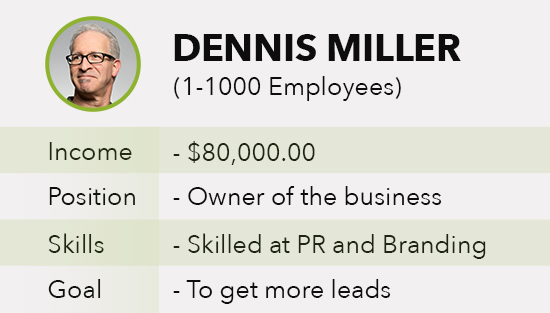You’ve just had a child, and you’re in love.
A brand new brainchild.
You’ve outlined and executed your company’s online marketing strategy. You step back and beam with pride, ready to watch it grow your business.
You couldn’t wait for this moment—but are you feeling underwhelmed?
Do the results have you wondering if your customers are truly engaging with your brand? Are you concerned if you’ll see a good return on your investment?
You need to make sure your online strategy is working. You want to measure the effectiveness of your marketing efforts. You want to keep up with fast-changing Search Engine Optimization (SEO) best practices. And if you spot areas with little growth or activity, you want to make the right adjustments.
These seven suggestions will help you refine your online strategy and send you on your way toward sustainable results.
1. Hone in on your audience.
Who are you talking to? You won’t know the answer until you get to know your customers, the past, present, and potential customers. It’s crucial to understand where they’re coming from and what they’re searching for. What interests them? What makes them tick?Yes, you want to find out this information. But how do you get to know them without ever meeting them?
You can find the answer in building data-driven buyer personas.

“A buyer persona is a semi-fictional representation of your ideal customer based on market research and real data about your existing customers.”
Buyer personas give you a basis for relating with your potential customers. They help you understand their patterns and behaviors, so you can better guide them along the buyers’ journey. You’ll want to create these personas based on data from potential customers, turned customers, and finally, loyal supporters.
In a nutshell, you’ll want to:
- Interview customers
- Identify trends
- Create tailored website forms
- Finally, use the information and data to transform your strategy
If you’d like to go more in-depth and even see an example persona, download our free guide: How to Create Buyer Personas for Your Business.
Creating a persona and implementing your strategy won’t happen overnight. But having a clear, defined audience through buyer persona research will propel your content marketing strategy.
2. Focus on user experience.
In today’s technology-driven world, it’s all about the user experience (UX). A successful UX puts the users first by designing an online presence specifically for them, while still keeping the company goals in mind.
Yes, your brand matters, but how your customers relate and interact with your brand matters more. Here are a few areas where your website should excel:
 Quick load time
Quick load time
And boy, do we mean quick. While the average load time is between 8 and 11 seconds, a best-practice benchmark is under three seconds. And that’s just in general. For mobile, the stakes are higher. A recent Google study said:
“53% of mobile site visits leave a page that takes longer than three seconds to load.”
Easy navigation
Think about how you want your customers to use your website. What page do you want them to see first? What links need to appear prominently no matter which page they start on? And most importantly, where do you want them to end up?
The obvious place to start in your navigation audit is your navigation menu. Whether it’s the top bar on the screen, a collapsible mega menu, or a bottom-of-the-page footer menu, make sure users can easily refer to the navigation menu for guidance.
Be clear with your page titles listed in your navigation. If “About” does the job, no need to make the page title longer by saying “Who We Are” or “Read About Our Story,” unless the type of content demands a more personal approach. In most cases, short, sweet, and straightforward page titles in the navigation menus perform best.
Declutter your menu if necessary. Trim it down to a few pertinent options, and put the rest in the footer menu, or “The Junk Drawer,” as Donald Miller, CEO of StoryBrand, likes to call it.
“[The Junk Drawer] might include links to Contact, FAQ, About, Employment options, etc. Those areas are easy to find for those who are looking, but they don’t clutter up the top section and confuse potential customers.”
Ready-to-go, useful material
Providing customers with curated material means you’re giving them useful and thorough content they can put to use in their own endeavors. With your consumers in mind, give all the necessary resources—other blog posts, statistics, or pertinent research—even if that means linking to a different page. (Just make sure that page opens in a new tab instead of completely directing them away from your site.)
The goal here is to give customers what they came for, either through your own content or curated content linked on your website. Whatever the page title promises, deliver it. And give them enough additional information to take action.
Provide value to your customers, not just a product.Be a generous brand. Make your audience feel like you value them enough to give them something extra, show or teach them something—even if they haven’t given you any money yet.
But what does it mean to be a generous brand?
Are you supposed to give products and services for free? Or maybe at a discount rate? Not exactly. We do want your business to grow, after all.
Being a generous brand means offering value to your consumers early in the buyers’ journey, and that can take form in a myriad of ways. Here are three ways to be generous to your consumers:
- Give away content that teaches, like PDFs, podcasts, and blog posts.
- Instead of marking down, add value with extras and bonuses.
- Keep the marketing plan clear and concise, so as not to waste your customers’ time.
Remember, the goal here is not to give away products and services. You’re wanting to show your potential customers just how valuable your products and services are by being a valuable brand—one who puts customer needs first.
Say you sell bedazzled hair clips. Content to give away could be videos of fun hairstyles to do with hair clips (especially bedazzled ones!). An added value might be “Buy 4 and get the 5th free!” or “Buy a pack and get a hairstyle guidebook!”
Then to save your customers’ time, organize your content in a way that makes sense for the buyers’ journey: a description of bedazzled hair clips, photos, testimonials and reviews, a how-to guide, an instructional video, etc. And next to all your content, use a call to action (CTA) buttons that catch the eye.
4. Use clear CTAs.
If people are coming to your site, it’s likely they already need whatever product or service you offer. Make sure to clearly emphasize exactly what they need to do to purchase it, download it, share it, etc.
It might seem like a no-brainer, but this is an easy thing to overlook. Even if your potential customers fall in love with your product, if they’re confused about where to go to buy it or what to do to place it in your website’s shopping cart, chances are they’ll give up.
To make sure this doesn’t happen, be generous with your CTA placement—at the top of the page, after an explanatory paragraph, next to the testimonials… anywhere that is relevant.
Remember, your CTAs don’t always have to say “Buy Now.” Other examples include:
- Download PDF
- Sign up for our newsletter
- Register for the next webinar
- Call now
- Watch this video
- Fill out this survey
- Start your free trial
Whatever your CTA is, be sure to use clear and actionable language. Choose verbs that tell your consumers exactly what their next step should be.
5. Showcase reviews and testimonials.
This is a big one for your content marketing strategy.
Think of the last time you made an online purchase. Did you only look at the pictures of the product? Did you only read the company-written product description?
Of course not. You read the reviews.
You wanted to know what real customers had to say about the product and the company. Is it a quality product? How was customer service? Did the product perform as expected? Do they recommend it to their friends?
Online reviews and testimonials comprise the Internet’s version of word-of-mouth marketing. When a consumer likes your product or service they want to tell others, which helps spread brand awareness. They write a review, a potential customer reads it, buys the product, and—if they’re happy too—continue the chain of positive reviews.
So, for that reason, you’ll want to showcase your reviews. That can be through pull-outs or even a comment section. Something to note about having a comment section is that you must reply to every comment—good or bad. If they ask a question, follow up. If they had a complaint, address their concerns and apologize if appropriate. Above all, respond with kindness and empathy.
6. Be smart with social media.

Having a website is foundational for your online presence, but having various, active social media accounts is a crucial next step for your entire marketing campaign. As a facet of the campaign, your social media strategy has to be well thought out.
Think back to the first tip about knowing your audience. After you’ve clearly defined who your ideal consumer is, go meet them where they are.
- A busy mom might be sharing the kids’ accomplishments on Facebook, pinning on Pinterest, or getting inspiration from mommy bloggers on Instagram.
- The modern-day millennial could post on YouTube when they want to talk through a specific topic with their audience or share a new lifehack they discovered.
- And we all know public figures like to take to Twitter to voice their strong, sometimes highly-controversial opinions.
Whichever social media platforms your audience uses most often, you should not only have an account, you should have a highly active account. And let me tell you why.
First, for Google.
Active accounts are more likely to show up higher on Google search pages. Though it’s not the only factor for a high-ranking search spot, it certainly is a big one. The more posts, the higher Google search ranking, the more eyes on your site, the more potential purchasers.
Also, for your people.
If you’re a clothing company, you’ll want to constantly remind your potential customers of sales and season trends. You may even have tips for styling. In that case, you could be posting once or twice a day if you wanted—usually without bugging your customers.
Or let’s say you’re an accountant. Everyone needs to file their taxes, but not everyone knows how. So, they come to you. For the average Joe, tax season only comes once a year, which means monthly email newsletters or how-to blog posts could be helpful for your audience. Those monthly reminders will keep you top-of-mind for when tax season rolls around.
However often you post, the goal is for customers to think of you when they need a new pair of pants or help with taxes. To accomplish that goal, keep popping up in their news feed.
Remember, it’s not necessary to be on every platform because your audience may not be everywhere. Through research, find the most-used platforms and start there. It doesn’t matter how many platforms you have, what matters is the amount of engagement.
Below are the current, most popular social media sites to choose from. Do your research, create accounts/rebrand current ones, and get to posting!
A major marketing tactic to increase brand awareness is engagement. Remember, real people live on the other side of the screen. Talk with them like they are. Engage with them. Encourage them to share your content with—you guessed it—clear CTA buttons.
The more you humanize your brand, the more they’ll listen.
7. Create engaging, meaningful content.
 This final point should be the cornerstone of your content marketing strategy.
This final point should be the cornerstone of your content marketing strategy.
You can be doing every other Search Engine Optimization (SEO) practice just right—you can have unique meta descriptions, perfectly formulated headlines, and well-used, top-ranking keywords—but if the body of your content isn’t relevant to your audience, none of that matters.
Your words should be well thought out and well researched. Your audience needs to know they can trust you.
Pique their interest. Give them a reason to be curious. Show them your product or service has more value to them than a sneaky scammer.
Your words should also resonate with your reader and entice them to take action. After reading your piece, you want your audience to not only remember it but share it with their friends. It needs to be better than good.
It needs to be memorable.
Address their concerns and answer their questions. Listen to their pain points and help alleviate them. If it’s thrills they’re seeking, thrill them!
Bottom line, figure out what they want, and be the one to give it to them.
Envisioning your online strategy
Odds are you have envisioned your future.
You’ve thought about what color house you want, if your next vehicle should be practical or not, what kind of a grandparent you hope to be, all that jazz. But have you taken time to envision your company’s future like that?
What impression do you want your website to leave on your audience? How do you want your brand to be regarded by potential customers? Do you see your company as an informative Instagram presence or a witty Twitter voice?
This is the best place to start, whether you’re recreating your online marketing strategy from scratch or deconstructing things to build an updated image. Brainstorm, document and transform your content marketing strategy into something bold and effective. These steps will help you along the way.
Creating or modifying a content marketing strategy can be daunting, but the payoff is worth the effort. Need help getting your strategy up and running?


Submit a Comment
Your email address will not be published. Required fields are marked *